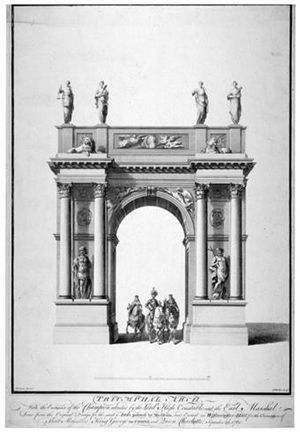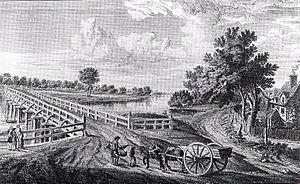William Oram facts for kids
William Oram (born around 1711, died 1777) was a talented English artist and architect. He was known for his beautiful landscape paintings and his important architectural designs.
Early Life and Career
William Oram first studied to become an architect. He was very skilled, and a powerful person named Sir Edward Walpole helped him get a job. This job was "master-carpenter" for the Board of Works, which was in charge of government buildings.
One of Oram's most famous architectural designs was a grand arch. He created this special "triumphal arch" for the coronation of George III of Great Britain. A coronation is a ceremony where a king or queen is officially crowned. People even made prints of his arch design.
Besides architecture, Oram also spent a lot of time painting. He loved to paint landscapes, which are pictures of nature scenes. His painting style was similar to a famous artist named Gaspar Poussin.
People often called him "Old Oram" to tell him apart from his son, who was also an artist. William Oram passed away on March 17, 1777. He left behind his wife and his son, Edward Oram, who also became a landscape painter.
William Oram's Artworks
William Oram was a very busy artist. He created many paintings and drawings. Some people thought his painting style was like another artist named John Wootton. It's possible Oram even learned from Wootton. He also made lovely watercolour drawings, similar to the style of Richard Wilson.
Many of Oram's artworks were used to decorate homes and important buildings. His paintings were often placed above doors or fireplaces. He even designed and painted the staircase at Buckingham House, which is now known as Buckingham Palace! He also helped fix paintings on the staircase at Hampton Court, another famous royal palace.
In 1745, Oram made an etching of Datchet Bridge. An etching is a type of printmaking. Later, in 1766, he showed three of his landscape paintings at an art show held by the Society of Artists of Great Britain.
William Oram's Lasting Impact
William Oram left a will, which is a legal document about what happens to a person's belongings after they die. In his will, dated January 4, 1776, he said he lived in St. John's, Hampstead. He left everything to his wife, Elizabeth.
After William Oram died, his wife gave his notes and writings to a relative named Charles Clarke. Clarke was an antiquarian, someone who studies old things. In 1810, Clarke used Oram's notes to publish a book. The book was called Precepts and Observations on the Art of Colouring in Landscape-Painting. This book shared Oram's ideas and advice on how to paint landscapes.



